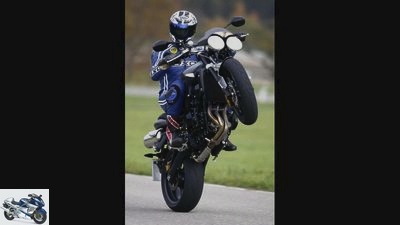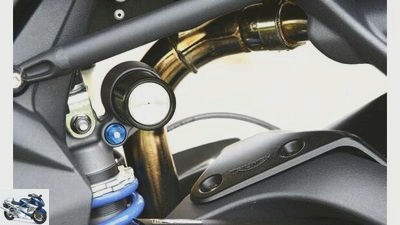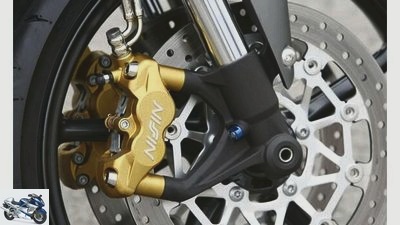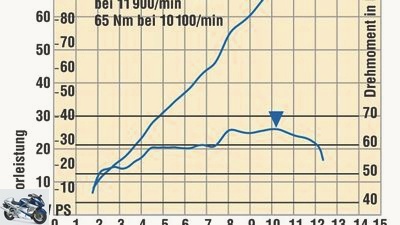Table of contents

fact
motorcycles
Test: Triumph Street Triple R
Test: Triumph Street Triple R
Mr. R
Content of
Mr. R is a respectable person. Not because he wears a uniform, adorns himself with wild war paint or shows off with irrepressible performance, but because he stands inconspicuously in the corner and exudes relaxed serenity. Where does this sovereignty come from??
Robert luck
12/12/2008
The memory is still fresh: test drives with the Triumph Street Triple for the naked bike comparison test in PS 11/2007 were due. Everyone fought for the new, the over-babe in this class, the Triumph Street Triple. After a wave of euphoria triggered by the presentation, everyone was excited to give the little naked Brenner the spurs. In the end, a safe test victory jumped out for the little triple. Two points ahead of the rest, a real number in such a tight test field.
Then a call to the Triumph inventory and press man Uli Bonsels. “You Uli, the new one is really great, but the suspension setup has become really very soft. You could still add something.” The answer was something like: “…blabla, costs, the chassis is perfect for the country road, … blah, blubber …” The Triumph Pinocchio knew even then that he was working hard on the project “R.”, So that Mr. R, with whom we are dealing today, is being worked. Certainly not a nice hour for him not to be able to tell the truth.

fact
The shock absorber finally has the necessary taker qualities; it’s even adjustable.
But sponge over it, Mr. Bonsels is doing his job, PS too. And the PS mandate is: testing. So bring on Mr. R, who primarily received an upgrade on the chassis. “Everything the same as before”, attests to sitting up. Not quite, because even when standing, Mr. R bends much less than his soft sister. Yeah, that feels very promising. The triple grumbles willingly at the first button, enveloping you in a warm carpet of sound. So up and away, to the paved curved belts, taking advantage of the last sunny autumn days.
The outskirts of the city glide out of the rear-view mirror with verve and smack, lingering behind the horizon. Mr. R willingly pulls on the leash, presenting himself as a supple glider, especially in the middle speed range. For full-blown 3.0-liter TDI sedans, all it takes is a tug on the gas and the road in front of you is free of rolling harassment again. Up to here, that is, during smooth power cruising, the standard Street Triple is already shining and above all is one thing: joy. So off, ignite the next stage. Into the northern Black Forest, on the empty, often heavily scarred streets, the darkest of all visors firmly closed and the street fighter mode activated in the brain. Speeds over 9000 / min are due, the Mr. R goes off like Hulle. Its 96 hp measured on the rear wheel are very digestible to dose, i.e. creamy to use.

fact
The stoppers come from the Daytona 675 and also shine on the naked bike.
In these fast moments in life, the chassis is the be-all and end-all, feedback and transparency are decisive, not the sheer engine power on the cornering speed. Because only those who can trust to be able to accelerate again after the apex of the corner will be motivated accordingly. This is where Mr R’s hour strikes: His good balance and the sporty, firm damping ensure very neutral and predictable steering behavior. The fork and shock absorber offer easy-to-use adjustment ranges with plenty of reserves and, in 95 percent of all cases, create a great compromise between comfort and sporty firmness. The latter, however, has its price, because the Mr. R does not have any bad, but at least existing approaches to handlebar slap. However, you only feel it when the attack is really bad on rough asphalt.
The braking system taken over from the Daytona with the chic, radially screwed pliers can also convince. However, the progress compared to the floating saddles of the standard version is rather marginal here, because even the cheap stoppers acted very precisely and efficiently. All in all, the path that Mr. R is walking is the right one. It offers more potential for the sporty driver without sacrificing too much driving comfort. However, Triumph can also pay for this progress: The Herr R is 800 euros more expensive than the standard Streety. If you are in a quandary that you already own a Street Triple without an R, the following is advised: take out the original chassis, have it reworked by a specialist and then, nonchalantly, pour one for Mr.R. Good idea, right?
Conclusion: Triumph has reworked the big litter of the little nudes in the right place and to the right extent. Congratulations on this Street Triple R, this amazing motorcycle that sends young and old, sporty and tourist pilots alike completely delighted on cloud nine.
Technical data – Triumph Street Triple R

The 675 three-cylinder is a fabulous engine. Thanks to a few small interventions and modified mapping, the former super sports car drive is a source of joy. Full power in every speed range and good manners – heart, what more could you want?
(Power on the crankshaft, measurements on Dynojet roller dynamometer 150)
Drive: Three-cylinder in-line engine, 4 valves / cylinder, 78 kW (106 HP) at 11700 / min *, 68 Nm at 9100 / min *, 675 cm³, bore / stroke: 74.0 / 52.3 mm, compression ratio: 12.7 : 1, ignition / injection system, 44 mm throttle valves, mechanically operated multi-plate oil bath clutch, six-speed gearbox, G-Kat
Landing gear: Light alloy bridge frame, steering head angle: 66.1 degrees, caster: 92 mm, wheelbase: 1390 mm. Upside-down fork, Ø fork inner tube: 41 mm, adjustable in spring base, rebound and compression. Central spring strut with deflection, adjustable in spring base, rebound and compression stage. Suspension travel front / rear: 120/130 mm
Wheels and brakes: Light alloy cast wheels, 3.50 x 17″/5.50 x 17″, Front tires: 120/70 ZR 17, rear: 180/55 ZR 17. First tires: Dunlop Qualifier. 308 mm double disc brake with four-piston fixed calipers at the front, 220 mm single disc with single-piston floating caliper at the rear
Measurements and weight: Length / width / height: 2030/755/1110 mm, seat / handlebar height: 825/1020 mm, handlebar width: 730 mm, 192 kg fully fueled, v./h .: 49.2 / 50.8%
Rear wheel power in last gear: 70.5 kW (96 PS) at 216 km / h
Driving performance: Acceleration 0 100/150/200 km / h: 3.7 / 7.0 / 13.8 s, torque 0 100/100 150 km / h: 4.8 / 5.8.9 s
Top speed: 216 km / h *
Consumption: Fuel type: Super unleaded. Average test consumption: 6.5 liters / 100 km, tank capacity 17.4 liters, range: 268 km
Base price: 8640 euros (plus additional costs)
* Factory specification
Related articles
-
Comparison test Ducati 1098S, Honda Fireblade, KTM 1190 RC8, Triumph Daytona 675, Yamaha YZF-R6
Jahn motorcycles Comparison test Ducati 1098S, Honda Fireblade, KTM 1190 RC8, Triumph Daytona 675, Yamaha YZF-R6 Comparison test Ducati 1098S, Honda…
-
Comparison test Kawasaki Ninja ZX-6R, Triumph Daytona 675, Yamaha YZF-R6
Fact 9 pictures triumph 1/9 Triumph Daytona 675 triumph 2/9 Triumph Daytona 675 triumph 3/9 Triumph Daytona 675 triumph 4/9 Triumph Daytona 675 triumph…
-
Triumph Street Triple – Series, Cup, Tuning
K motorcycles Triumph Street Triple – Series, Cup, Tuning Triumph Street Triple – Series, Cup, Tuning Family Day Content of Three sisters: they have a…
-
Bilski motorcycles Comparison test: KTM 990 Super Duke, Moto Morini Corsaro 1200 Veloce, Triumph Speed Triple, Yamaha FZ1 Comparison test: KTM 990…
-
Street Triple RS and Speed Triple RS
Arturo Rivas 11 pictures Arturo Rivas 1/11 It’s about the subtle differences between Triumph Street Triple RS (in gray, or. “Matt Silver Ice”) and…
-
fact motorcycles Comparison test: Honda CBR 600 RR, Kawasaki ZX-6R, Suzuki GSX-R 600, Triumph Daytona 675, Yamaha YZF-R6 Comparison test: Honda CBR 600…
-
Triumph Speed Triple 1200 RS: Almost everything new
News 2022 New motorcycle items for 2022 Triumph Motorcycles 44 pictures Triumph Motorcycles 1/44 The new Speedy 1200 RS has new headlights that are very…
-
Triumph Speed Triple conversion: Workhorse monocoque
Antoine Hotermans 12th pictures Antoine Hotermans 1/12 Seven years ago, Brice began converting the 2009 Speed Triple. Antoine Hotermans 2/12 In 2021…
-
Handling test part 2: Triumph Street Triple R
jkuenstle.de accesories landing gear & Spring elements Handling test part 2: Triumph Street Triple R Handling test part 2 The handling test with the…
-
Editor’s two-wheeler treasure: Triumph Street Triple
Jahn 12th pictures fact 1/12 At the Intermot, Triumph is presenting a completely redesigned Street Triple including the higher-quality R version with…